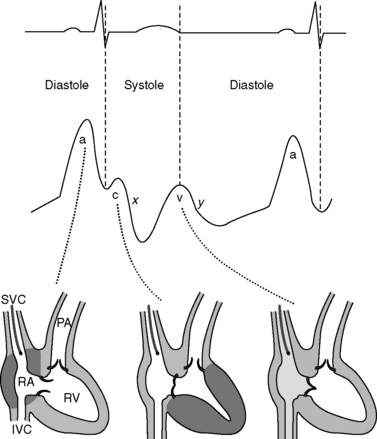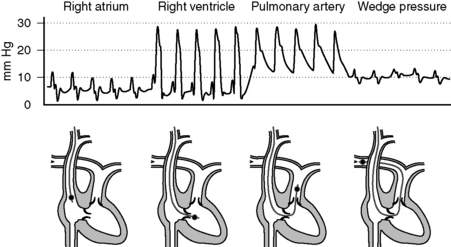Chapter 6 Hemodynamic Monitoring
4 In what situations should arterial line placement be considered?
 Inability to obtain noninvasive blood pressures.
Inability to obtain noninvasive blood pressures.
 Hemodynamic instability. Patients who need monitoring because of extremely high blood pressure, extremely low blood pressure, or extremely volatile blood pressure.
Hemodynamic instability. Patients who need monitoring because of extremely high blood pressure, extremely low blood pressure, or extremely volatile blood pressure.
 Need for rigorous blood pressure control. Patients who need blood pressure kept within a tight range (e.g., status post aortic aneurysm repair).
Need for rigorous blood pressure control. Patients who need blood pressure kept within a tight range (e.g., status post aortic aneurysm repair).
 Need for frequent arterial blood sampling. Patients with severe ventilation compromise, oxygenation compromise, or other condition where it is useful to follow serial laboratory values with an arterial line.
Need for frequent arterial blood sampling. Patients with severe ventilation compromise, oxygenation compromise, or other condition where it is useful to follow serial laboratory values with an arterial line.
7 Describe the central venous waveform components. Which part of the waveform cycle should be reported as the central venous pressure?
Central venous pressures have predictable waveforms. These waveforms have upward deflections representing atrial contraction (“a” wave), ventricular contraction that causes the tricuspid valve to bulge into the atrium (“c” wave), and passive venous return of blood during diastole (“v” wave). (Note the somewhat counterintuitive fact that ventricular contraction coincides with the “c” wave, not the “v” wave.) The downslope after the “c” wave is called the “x” descent, and the downslope after the “v” wave is called the “y” descent. See Figure 6-1.
10 Describe normal pressures and waveforms encountered as a PAC is advanced
The right atrial pressures are similar to central venous pressures described in question 7. Right ventricular pressures will have systolic components that are in phase with (i.e., occur synchronously with) systemic arterial systolic pressures and have low diastolic pressures that increase during diastole. Systolic pulmonary arterial pressures will also be in phase with systemic arterial systolic pressures and have similar waveforms that gradually decrease during diastole. The pulmonary artery occlusion pressure (PAOP)—or wedge pressure if no balloon is used—reflects the left atrial pressure and thereby left ventricular filling. Because the wedge pressure reflects the left atrial pressures, it may have “a,” “c,” and “v” waves, although in practice these may difficult to identify. Large “v” waves due to mitral regurgitation can occur on the PAOP trace, but these large “v” waves will occur during late systole and early diastole. See Figure 6-2.
< div class='tao-gold-member'>

Full access? Get Clinical Tree




